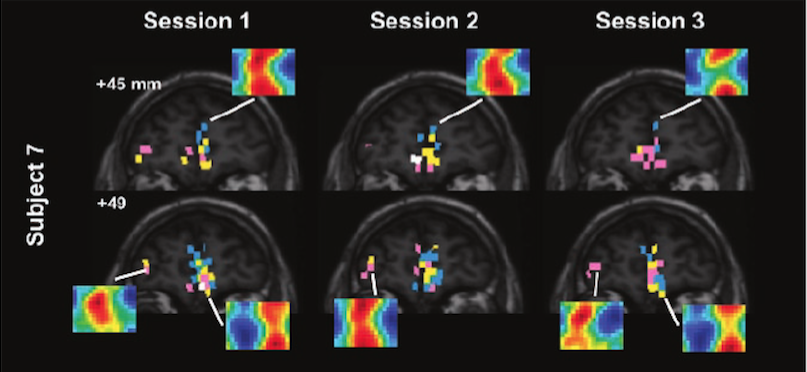
Title of paper under discussion
The Cortical Topography of Tonal Structures Underlying Western Music
Authors
Petr Janata, Jeffrey L. Birk, John D. Van Horn, Marc Leman, Barbara Tillmann, Jamshed J. Bharucha
Journal
Science, vol 298, pp 2167-2170 (2002)
Link to paper (free access)
Overview
Using functional magnetic resonance imaging (fMRI) Janata and his colleagues identified a region towards the front of the brain – the rostromedial prefrontal cortex – that is sensitive to tonality. During a listening experiment, different small areas within this region were sensitive to different keys, eg area 1 to A minor, area 2 to D flat major etc. But when the experiment was repeated those areas, though still responding to tonality, were not necessarily still sensitive to the same key as before – area 1 might now be sensitive to A flat major, area 2 to F sharp minor. Hence, claim the authors, the ‘tonality structure’ is maintained as a ‘dynamic topography’, situated in a brain region known to be connected to other regions processing emotion, thought and sensation.
Introduction – tonality and the torus
The relationship between keys in Western tonal music can be represented by the circle of fifths:
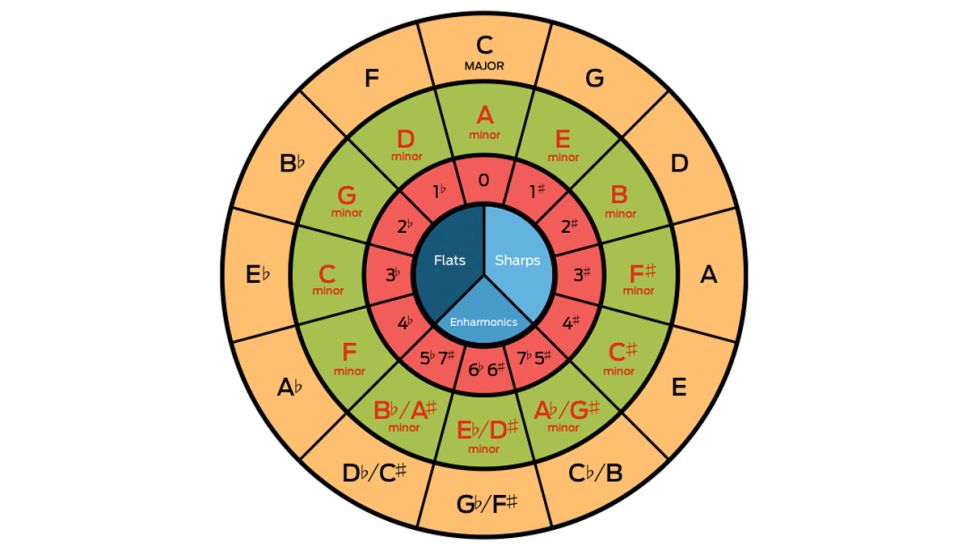
as a lattice work:
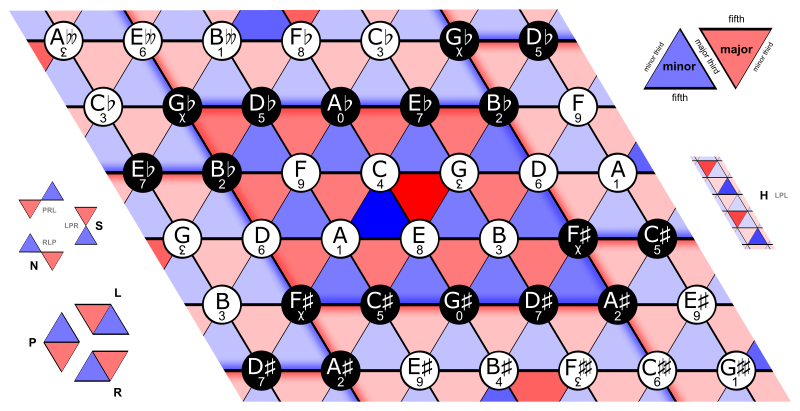
or, three dimensionally, on the surface of a rubber ring (mathematically speaking a ‘torus’):

Janata and his colleagues, working in Dartmouth College, USA, used this tonality-sensitive torus as a ‘graphic’ for this paper. Imagine playing tonal music to a blank version of this torus – and if it was in C major, the C major-sensitive area of the torus would go deep red (with areas sensitive to related keys more yellow or green and so on down the spectrum); if it was in G minor the G minor-sensitive area would go deep red, and so on. But instead of showing the torus in 3D, imagine now slicing through the ‘trunk’ of the rubber ring then opening the whole thing out, so it becomes a flat sheet of ‘rubber’. It still depicts the C major, G minor etc areas, but now in 2D rather than 3D. This is the graphic Janata uses to display tonal-sensitivity, an opened-up rubber ring (or ‘2D torus’).
For this study the research team used a piece of music that “systematically modulated through all 12 major and minor keys”. As the piece was played to the (computer-generated, tonality-sensitive) ‘2D torus’, the activity on the torus constantly changed in line with the changing tonality. Here are all 24 keys, with pictures of the average activity pattern during each key’s time window depicted below:
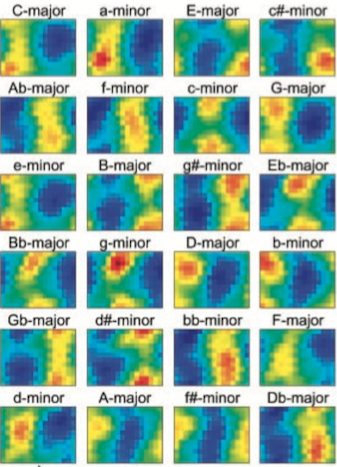
So each moment in the piece elicits a pattern on the 2D torus. When the same piece was played to a living breathing participant, and a particular brain area was excited by particular moments in the piece, the average ‘2D torus pattern’ described by those moments was used to illustrate that brain area’s tonality sensitivity (see later).
Experiment – method
8 musically experienced listeners underwent fMRI scanning as they listened to the constantly modulating piece of music described above. They performed a tonality-listening task during the experiment to ensure they were concentrating on the tonality of the music. [They then performed a different listening task so that statisticians, who were looking specifically for ‘tonality-related’ brain activity, could remove ‘task-related’ activity from the scans in their analysis].
The same listeners returned the following week, and the week after that, to go through the exact same procedure.
Results
Tonality-related brain activity was shown to be mainly localised in a region of the brain called the rostromedial prefrontal cortex (RPC), “primarily in the rostral [front] and ventral [underneath] reaches of the superior frontal gyrus”:
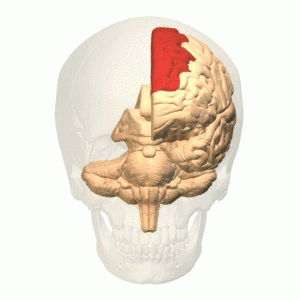
Each listener exhibited areas of tonality-sensitivity in their RPC, with different areas (represented as individual voxels on the fMRI scan) sensitive to different tonalities in the piece of music. So, for instance, one area might ‘light up’ mainly when the piece moved into B major, and another mainly when the piece was in F minor. Moreover, each listener’s pattern was unique. And further still, each individual listener’s pattern often changed from trial to trial, so that, for instance, an area that was sensitive to B major might in the next trial be sensitive to E major instead. So, in the words of the authors, “what changed between sessions was not the tonality-tracking behaviour of these brain areas but rather the region of tonal space (keys) to which they were sensitive.”
The tonality-sensitivities of individual areas, in three different listeners across their three different listening sessions, are here represented by the ’2D torus’ images those particular tonalities would evoke:
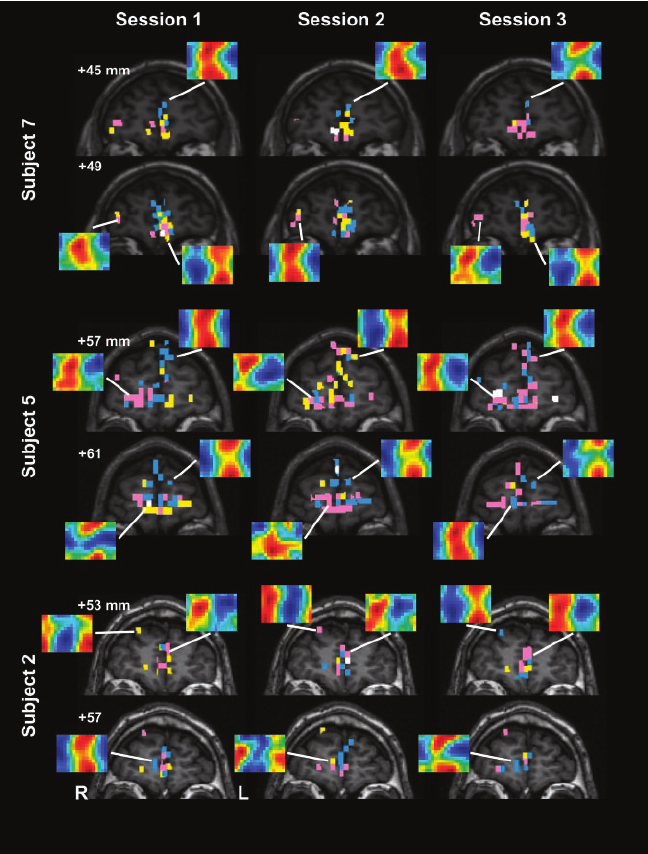
Discussion
Tonality, and especially its modulations in musical scores, can evoke emotions and even movement, so it is no surprise that a map of tonality is maintained in a region of the brain – the RPC – known to have widespread connections not just to auditory areas of the brain but also to emotional and cognitive areas. The paper under discussion here is not the only research to suggest that tonal knowledge lies outside the main auditory areas of the brain – people with bilateral damage to auditory cortex have been shown to retain “the ability to generate expectancies based on tonal contexts”.
What of the paper’s main finding, the phenomenon whereby the pattern of tonality representation within the RPC may change from session to session, described as ‘dynamic topography’? In parts of the brain discriminating between classes of visual object (eg face, cat, man-made object, nonsense), the assignment of brain area to class appears to be “topographically invariant”, with a particular class assigned to a particular brain area. But when it comes to discriminating between tonalities, our researchers “found that the mapping of specific keys to specific neuronal populations in the rostromedial prefrontal cortex is relative rather than absolute”. The authors explain that “in contrast to categories of common visual objects that differ in their spatial features, musical keys are abstract constructs that share core properties. The internal relationships among the pitches defining a key are the same in each key, thereby facilitating the transposition of musical themes from one key to another.” This allows for brain areas, in respect of the different tonalities they represent, to be “dynamically allocated from one occasion to the next”.

Coda
Johann Sebastian Bach
Das Wohltemperierte Klavier Teil I (The Well-Tempererd Clavier Book I)
Piano: András Schiff